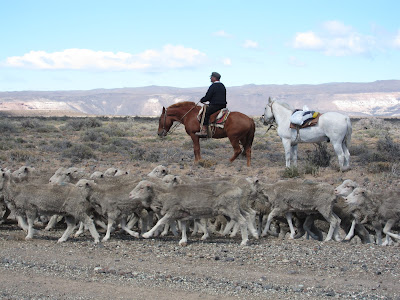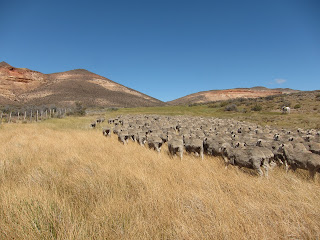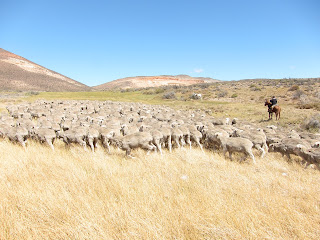SHEEP AT THE ESTANCIA “LOS PINOS” Feb. 2013
My friend Gerardo and I traveled to la Estancia (farm) of
Carlos Abait to buy 500 sheep and bring them back to Gerardo’s Estancia. Aniceto Cayuñanco, the peon that lives at Gerardo’s farm
rode two days with his 2 sheepdogs to get to Carlos’ farm. It would be his job
to bring 500 sheep back to Gerardo’s alone. This is rugged country, very rocky
with mountains, valleys and broad flat plains the predominate features. He
knows this country. He was born ‘up the road in a village of 40 people. His
nickname is ‘choique mora’meaning ‘black ostrich’, a common bird found around
here. A Mapuche-T Indian who has worked his whole life on sheep farms, he
thought nothing of the task. He took an extra horse to carry his few positions,
his one working sheep dog and set out. He would have to move the sheep
according to the weather and would bivoc where he could locate shelter from the
rain and strong winds and let the tired sheep settle for the night. It was a 60
km drive from one Estancia to the other. It would take him 3 days to get the
sheep from one place to the other.
When we arrived at Carlos’ Estancia we were warmly greeted
since few visitors ever come by. He was expecting us.
With no phones or electricity communication is done by
radio. Radio, the old way. People living in very rural areas send messages to
the radio station in town (150 plus kms. away in this case) where they are
broadcast to others who sit by their radios in the morning or at night
listening for news. A typical message might be “ Juan and Maria are coming to
visit Gerardo Viviers at the Estancia Los Sauces on Tuesday next” or “Juana had
a baby boy in Sarmiento last Friday and will be returning to Estancia Los
Sauces next Monday’. Most all messages originate in towns rather than Estancias
unless the Estancia has power and some communications. Cell phones don’t work
out here and fixed line phones don’t exist.
Carlos’ farm is 23,000 hectares (2.2 acres per hectar)(over
50,000 acres of land) and he has 8-9,000 sheep roaming the rocky landscape. He
looses about 10% per year, mostly to foxes and mountain lions. This is an
ongoing issue and involves hunting and poisoning to try and limit the wanton
destruction of the sheep. A mountain lion will kill and partially eat a sheep
but kill 50 more as that is its nature. The same behavior goes for foxes.
Fox skins can bring 150 pesos or(about $25.00) as they are
sold. The other animal found in this area is the Liebre (rabbit). When the
population of rabbits is high, the mountain lion and fox hunt them, when low,
they go for sheep. I am told that a company was out shooting as many rabbits as
they could and the meat and pelts were being shipped to Germany. The unforeseen
consequence of this business was to greatly reduce a favored food source for
predators and increase sheep loss since fox and lion will hunt and kill what is
available.
Gerardo is paying $100.00 (U.S.) per sheep. They are 2 to 4
years of age and will live about 8 years. Gerardo figures that if he can
increase his own sheep population to 2000, he’ll get 10,000 kilos of wool each
year from the sheep. He’ll get $3.50 per kilo (depending on quality) which
gives him $35,000.00 a year. He’ll also get another $10,000.00 for meat sales.
This is before costs.
 Part of the process of marking the sheep for age, gender,and where they go next. 2,000 sheep passed through this process before their bath and injections.
Part of the process of marking the sheep for age, gender,and where they go next. 2,000 sheep passed through this process before their bath and injections. The Sky with strong winds a constant feature. Moving across the southern Pacific and over the Andes drops and creates incredible formations.
The Sky with strong winds a constant feature. Moving across the southern Pacific and over the Andes drops and creates incredible formations. Aniceto on the drive.The threat of rain has diminished and now the fear is high heat. If that happens the tired sheep will just stop creating problems of no water for them for miles.
Aniceto on the drive.The threat of rain has diminished and now the fear is high heat. If that happens the tired sheep will just stop creating problems of no water for them for miles. My friend Gerardo. We studied together in graduate school in Bs.As.,Argentina some 40 plus years ago.
My friend Gerardo. We studied together in graduate school in Bs.As.,Argentina some 40 plus years ago.











No comments:
Post a Comment